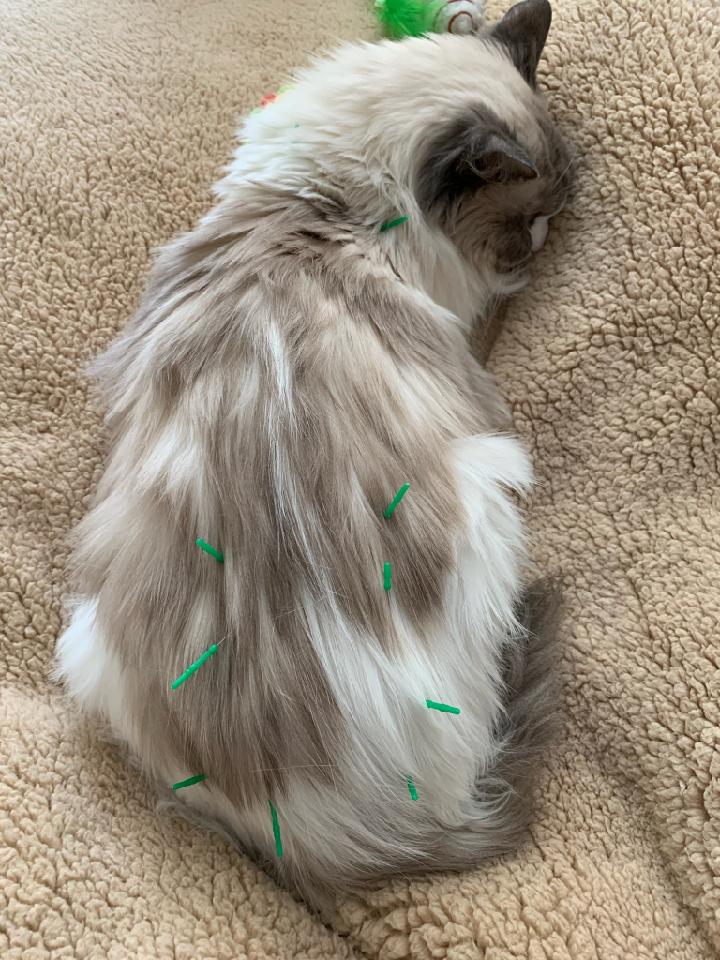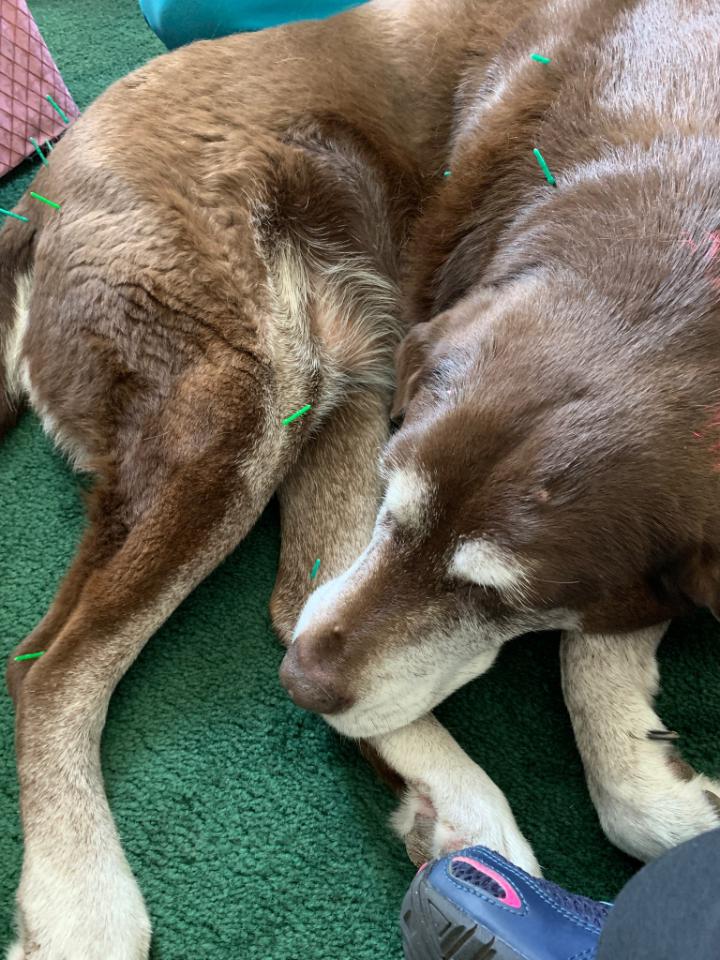Acupuncture therapy in pets
This nonpharmacological form of treatment, rooted in Eastern medicine, can help with a variety of conditions
Tabitha, an 18-year-old, sweet-natured feline was struggling to move comfortably around the household. Her owner had exhausted many of the options offered to help ease the pain she was experiencing from her arthritic joints. Acupuncture was suggested to Tabitha’s owner and, despite being a slight skeptic about the true benefits this treatment could offer, she scheduled a first acupuncture appointment for Tabitha.
Acupuncture therapy is used on a feline patient. (Photo courtesy of Dana Koch, VMD, CVA, MLAS)

Tabitha was a very cooperative patient and seemed to enjoy her acupuncture visits. After about 6 sessions, Tabitha’s owner noticed a little pep her step and improved movement with less stiffness. The treatments were continued over the course of the year, and the owner observed that Tabitha’s daily life improved as she began to groom better, sleep more comfortably, navigate into the litter box with more ease, and had an increased appetite. Amazingly, Tabitha did not require any pain medications while receiving her acupuncture treatments, and she was able to celebrate her 22nd birthday. Tabitha was a model display of the true benefits acupuncture could provide to our furry companions.
What is acupuncture?
Acupuncture has been around for thousands of years. This treatment originated in China, and traditional Chinese veterinary medicine not only includes the practice of acupuncture but also herbal medicine, food therapy, and Tui na (medical manipulation). Approximately 173 acupoints exist in animals and 361 in humans. Acupuncture generally involves the insertion of thin sterile needles into discrete and specific points on the body to cause a therapeutic effect. There are other methods utilized to enhance the effects of acupuncture, including electrical stimulation and moxibustion. Moxibustion utilizes dried plant materials called moxa, which are burned near the surface of the skin to help with treatment of certain conditions. Electroacupuncture uses a mild and gentle electric current to pass between the needles placed, causing a stimulation to help enhance the effects of acupuncture for certain conditions.
Helping patients with acupuncture
In terms of the effectiveness of acupuncture, there have been several studies that have demonstrated that the stimulation of acupoints leads to the release of β-endorphins, serotonin, and other neurotransmitters. Studies have further indicated that acupuncture can help with pain relief, promotion of tissue healing processes, regulation of gastrointestinal motility, immunoregulation, anti-inflammatory effects, and hormone regulation.
The best part of acupuncture therapy is that the treatment is extremely safe and rarely causes any adverse effects. Some results can be seen immediately, but others will require several treatments. Most animals handle the acupuncture needles very well and often even show a relaxation effect from placement of some of the points. The body has many channels that interconnect and can be stimulated through acupuncture therapy. Many veterinarians who practice acupuncture can use these channels to help several areas of the body, with only a few acupoints.
Practicing veterinary care with acupuncture
To become a certified veterinary acupuncturist, a practicing veterinarian must undergo extensive training to understand the history of acupuncture, the proper diagnosis of a patient, and the channels and meridians used in acupuncture therapy. There are several tests these trained professionals must complete to become proficient and certified.
A canine patient receives acupuncture treatment. (Photo courtesy of Dana Koch, VMD, CVA, MLAS)

In practice, I will often have owners offer an animal’s favorite treat or meal to make it a positive experience during acupuncture sessions. Most sessions will last between 15 and 30 minutes. Some of the most common conditions acupuncture is used for in animals includes musculoskeletal and neurologic injuries, gastrointestinal disorders, allergic dermatitis, lick granulomas, epilepsy, and chronic pain conditions.
Conclusion
For those interested in pursuing this treatment for a pet, I would recommend finding a certified veterinary acupuncturist nearby. They will want to review your pet’s full medical history and perform a thorough examination prior to any acupuncture treatments. The acupuncturist may also suggest diet changes or herbal medicine to treat your pet’s underlying issues.
I have found the most success with an integrative approach to treating my patients using elements from both traditional Western medicine (eg, radiographs, ultrasound, antibiotics) and Eastern medicine (eg, acupuncture, herbs). We are fortunate, at the present time, to have numerous options available to help our animals live longer and more comfortable lives.
Dana Koch, VMD, CVA, MLAS is medical director of the HousePaws hospital in Morrisville, Pennsylvania, which offers acupuncture services. She received her veterinary degree from the University of Pennsylvania and a master’s degree in laboratory animal medicine from Drexel University, both located in Philadelphia.
